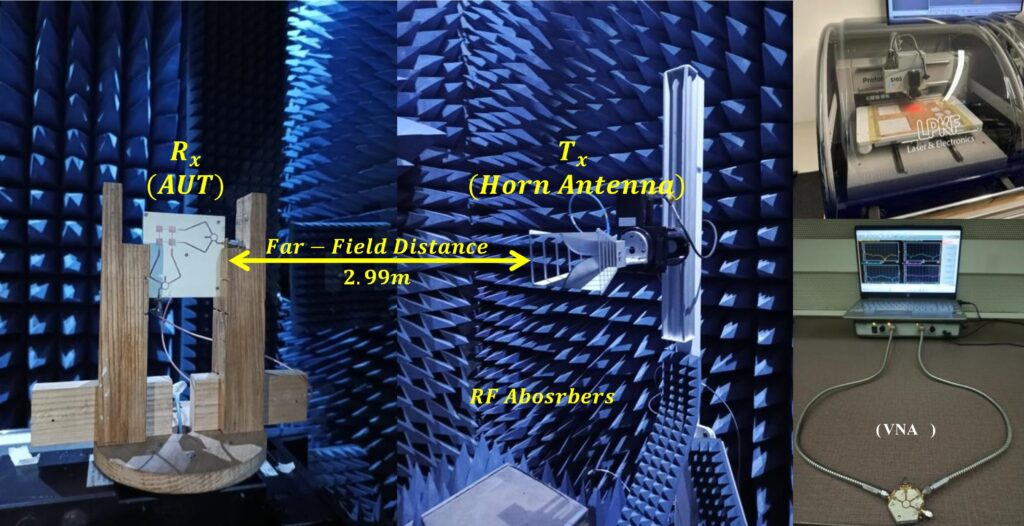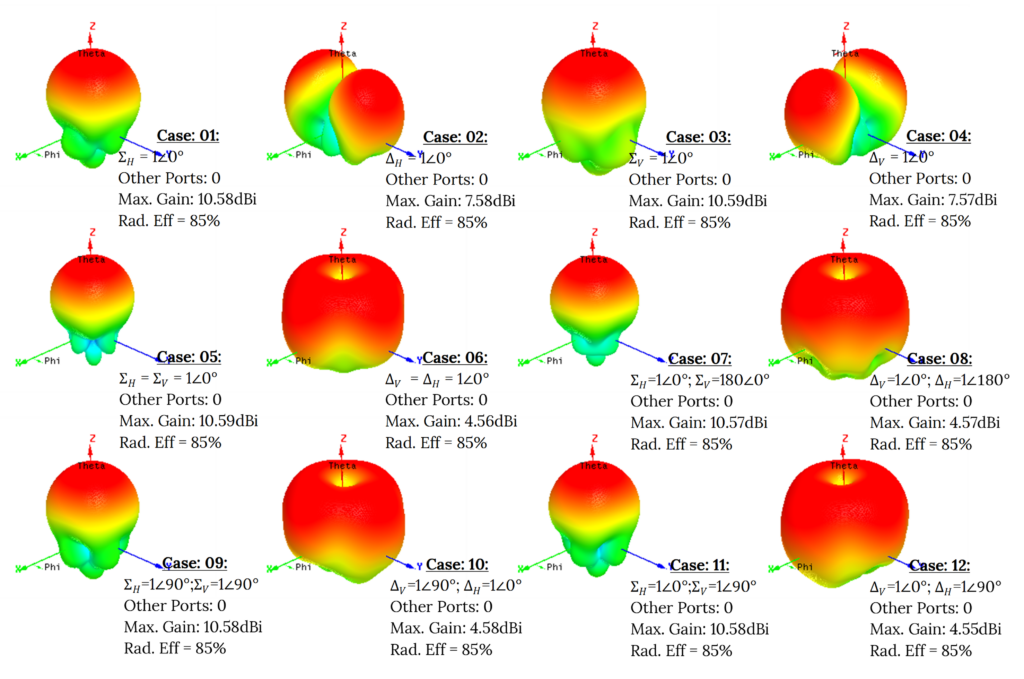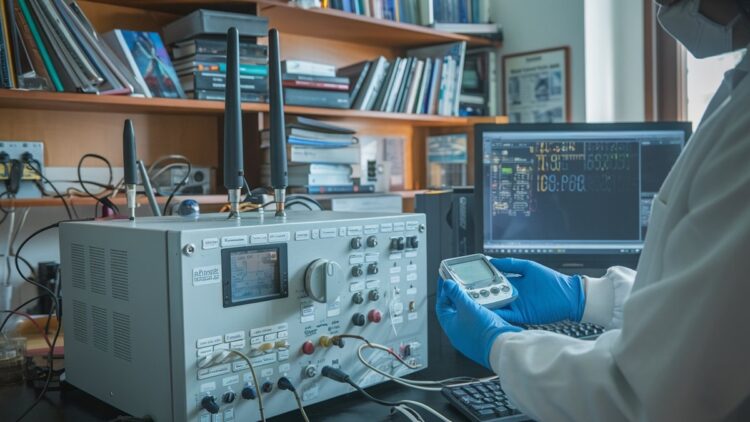

This blog presents a novel unambiguous monopulse direction-finding antenna system developed at NUST-SEECS. The proposed system is not only simple in structure, compared to state-of-the-art, but also have polarization reconfigurability feature.
I. Background:
Monopulse radars are used widely to measure the distance, speed, and angle of arrival of targets at a high speed of operation, since the necessary computations are performed in a dedicated hardware known as ‘monopulse comparator circuit’ [1]. In these systems, the antennas can be deployed in active & passive direction-finding (DF) applications encompass drones, aircraft, satellites, wireless fidelity (Wi-Fi) routers and mobile base station etc., as can be observed in the conceptual model that is shown in Fig. 1. `In particular, the dual-polarized antennas find profound utilization in polarimetric radars including synthetic aperture radars (SAR) and other radar polarimetric applications. Such radars not only have the capability to detect targets with reduced radar cross section (RCS) but also identify various targets in adverse weather conditions. Therefore, such systems are being employed for modern DF applications. Several techniques have been presented in the literature to realize the monopulse array antenna systems including waveguide horn antennas and planar antennas. However, there are few limitations associated with antenna systems such as waveguide horn antennas that cause an increase in size, cost and complexity of the overall system, while on the other side, the planar antennas including microstrip & substrate-integrated waveguides (SIWs) based antenna systems employed either multi-layered designs or have complex comparator networks to realize various either single or dual-linear/dual-circular polarizations.
![Figure 1: Conceptual Model [2]](https://researchblog.nust.edu.pk/wp-content/uploads/2024/10/Figure-1-1-1024x769.png)
II. Research Objective:
This work intends to design and development of first-ever, all polarization i.e., dual-linear (vertical and horizontal), dual-slant (±45) and dual-circular (RHCP and LHCP), series-fed, dual-axis monopulse antenna system for unambiguous direction-finding and polarimetric radar applications without compromising radiation characteristics and form-factor.
III. Research Gap in the Current Study:
The recently reported work requires either multilayered radiating structures or complex monopulse comparator circuit while realizing the either single polarization or dual-linear/dual-circular polarization. However, with the expeditious development of modern wireless communication systems instead of only high precision, radars also intend to obtain targets information in the polarization domain; for instance, polarimetric monopulse radars. Moreover, such polarization diversity increases the channel capacity and mitigate the multipath fading in advanced satellite communication systems.
IV. Novelty of the Proposed System:
To address aforementioned limitations, this research work presented a novel single-layered, seriesfed planar antenna system that may be incorporated in monopulse radars. The proposed design not only reduces the overall system complexity but also employed conventional 180◦ ring hybrid couplers as comparator circuit. The proposed design is capable of achieving different types of dual polarizations including horizontal, vertical, slant (+45◦ & -45◦), left-hand-circular-polarization (LHCP) and right-hand-circular-polarization (RHCP) [2]. For direction finding, the root-meansquare-error (RMSE) lower than 9◦ is achieved for both xoz-plane and yoz-plane in the field of view (i.e., −20◦ to +20◦) for different polarizations which can further be reduced using DF algorithms. The block level diagram of the proposed monopulse antenna system in shown in Fig. 2. To synthesize sum & difference radiation patterns with different polarizations, RF switches are employed along with 90◦ & 180◦ hybrid couplers. The fabricated design is highlighted in Fig. 3. The prototype is fabricated using 0.762-mm-thick Rogers 4350B substrate (ε𝑟= 3.66 and tanδ = 0.0031). The overall design dimensions are 100×100 mm2.
![Figure 2: Block diagram of the proposed polarization reconfigurable monopulse antenna system [2]](https://researchblog.nust.edu.pk/wp-content/uploads/2024/10/Fig-2-1024x659.jpg)
![Figure. 3: Fabricated monopulse antenna system [2]](https://researchblog.nust.edu.pk/wp-content/uploads/2024/10/Figure-4-1024x640.png)
V. NUST Contribution to the Research Study:
In this work, NUST had provided support towards antenna fabrication and characterization. In this regard, the prototype of the proposed antenna was fabricated & tested in Rapid Prototyping PCB Fabrication Lab and Anechoic Chamber respectively available at NUST-SEECS as shown in Fig. 4.

VII. Benefits of the Proposed System:
This proposed antenna system has potential applications in polarimetric radars and unambiguous dual-plane DF applications.
VIII. Plots of the System Performance:
The 3D radiation patterns are shown in Fig. 5.

The normalized measured gain patterns with different polarizations are shown in Fig. 6 (a-e). The peak gain of sum (Σ), difference (Δ) and bi-difference patterns is 10.5 dBi, 7.3 dBi and 4.5 dBi.
![Figure 6: Normalized 2D gain plots (a) in xoz-plane with vertical polarization, (b) in yoz-plane with horizontal polarization; in xoz-plane and yoz-plane with (c) +45° slant polarization, (d) –45° slant polarization (e) LHCP and (f) RHCP [2]](https://researchblog.nust.edu.pk/wp-content/uploads/2024/10/Figure-6-1024x576.jpg)
IX. Research Outcomes:
This research work presented a novel monopulse antenna system for unambiguous dual-axis direction-finding systems. The proposed structure is simple (i.e., single-layered) and series-fed having polarization reconfigurability feature. The system is able to achieve dual polarized sum (Σ) and difference (∆) patterns including dual-linear, dual-slant and dual-circular polarizations, while employing reduced number of hybrid couplers without compromising the compactness and radiation performance. Such attractive features make the proposed antenna system a potential candidate for dual-axis unambiguous direction-finding systems that can be deployed with drones, aircraft and satellite communication systems.
X. Possible Area of Collaboration:
This work is a joint collaboration of NUST-SEECS and Frederick Research Center & Frederick University, Cyprus, Military Technological College (MTC), Muscat, Oman and University of Galsgow, UK. It is further stated that researchres working in the area of direction-finding or direction-sesing applications may contact the principal investigator for potential collabroation.
XI. Funding Acknowledgement:
The research work was supported in part by Cyprus Research and Innovation Foundation under the Project EXCELLENCE/0421/0495–SMURFS that is implemented under the Cohesion Policy Funds “THALEIA 2021-2027” with EU co–funding, and in part by CODEVELOP-GT/0322/0081 REALISATION-GREEN-CLOUD that is implemented with EU co–funding – NextGenerationEU.
XIII. References:
[1]. N. Ahmad, H. Nawaz, N. Shoaib, Q. H. Abbasi and S. Nikolaou, “Ambiguity Resolution in Amplitude-Comparison-Based Monopulse Direction-Finding Antenna Systems,” in IEEE Antennas and Wireless Propagation Letters, vol. 22, no. 10, pp. 2605-2609, Oct. 2023, http://dx.doi.org/10.1109/LAWP.2023.3298664
[2]. N. Ahmad, N. Shoaib, H. Nawaz, Q. H. Abbasi and S. Nikolaou, “Dual-Polarized (CP, LP, Slant), Series-Fed, Monopulse Planar Array Antenna,” in IEEE Transactions on Antennas and Propagation,
September. 2024, http://dx.doi.org/10.1109/TAP.2024.3451169
The author is an Associate Professor and Head of Department at School of Electrical Engineering and Computer Science (SEECS), National University of Sciences and Technology (NUST), Islamabad and can be reached at nosherwan.shoaib@seecs.edu.pk.
Research Profile: https://bit.ly/48hQVKA
Engr. Noman Ahmad is a graduate student at School of Electrical Engineering and Computer Science (SEECS), National University of Sciences and Technology (NUST), Islamabad and can be reached at nahmad.msee21seecs@seecs.edu.pk.
Research Profile: https://bit.ly/3UpuJIP


![]()




